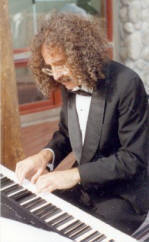Lincoln’s Address at Gettysburg, 1863:
Composer’s Notes
This composition was initiated by my invitation to the Rev. Jackie Ziegler, the new minister of the Unitarian Universalist Church of Boulder, to provide me with a poem I could set to music for her formal installation in March 2001. After a day or two of thought, she responded with what she admitted was not a poem but was in fact her favorite of all texts, the Gettysburg Address. Not knowing the difficulties it would present, I assented.
As I did the composing, I realized why no one else has ever put together a successful choral setting of the text: its verbal and contextual majesty aside, it has to be the most unmusical text ever contrived by a human! (Even Copeland wouldn’t touch it; in the "Lincoln Portrait," the text is recited over musical accompaniment.) The completion took me a month and a half longer to complete than anticipated. The version sung at the March installation was a "thinned down" version, but quite successful nonetheless.
To create the melodic line, I relied heavily on the words to music technique taught to me (posthumously, I think) by Arthur Sullivan (of Gilbert and Sullivan fame). If you say the opening line, "Four-score and seven years ago," you immediately hear a natural rhythm to the phrase. This becomes the melody’s rhythm. Say it again, this time listening to the inflection (the pitch) of the words. You can draw a line (kind of like following the bouncing ball) that represents the relative changes of pitch as you say the words. Transcribe the points of that line to the musical staff, and you’ve mapped the intervals (notes) of the melody. Good; you’re off to a good start! Now, continue that process for every phrase in the entire text, and among other things, you’ll discover that no two rhythm patterns are the same (except the obvious, like "of the people, by the people"), and the melody is more like meandering Gregorian chant than like a ballad. But with enough tempering of the melodies and rhythms, you conjure up a work that balances common elements with the uniqueness of each phrase. (It is somewhat analogous to balancing intervals when creating the tempered scale on the piano. They’re just a little bit off, but not enough to compromise the quality of the music.)
The Composer’s Interpretation
The following is an informal summary of the nature and intention of the music:
Lincoln’s Address is essentially in three parts: Grief, Anger, and Hope in Action. The grief is expressed musically with an instrumental funeral march accompanying the verbal expression of grief, the "why we are here." The second part, "Now we are engaged in a great civil war," addresses the anger. In the music is heard both the anger and the nature of the war itself. In the third part, Lincoln brilliantly takes that grief and anger, and transforms it into Hope in Action. He accounts for the grief and anger, and asks us to "dedicate ourselves" essentially as a living memorial to the dead by ensuring that the principles they fought for "shall not perish from the earth." Similarly, the music’s bitter-sweetness heralds this commitment with a final sense of optimism that this is indeed something we can achieve.
Of musical theoretical interest:
There is an eight-note pulse that retains its pace throughout the piece, yet successfully conveys three distinct moods.
The choral parts in the middle fast section are in a perfect four-part canon at the unison and octave.
The Pucciniesque theme is a transformed augmentation of the opening instrumental dirge, and the coda accompaniment is the opening theme transformed to major.
Don "Orfeo" Rechtman
